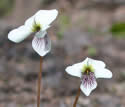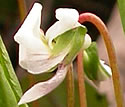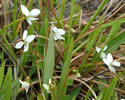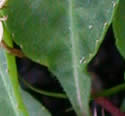Viola lanceolata (Lance-leaved Violet)
| Also known as: | Bog White Violet, Strap-leaved Violet |
|---|---|
| Genus: | Viola |
| Family: | Violaceae (Violet) |
| Life cycle: | perennial |
| Origin: | native |
| Status: |
|
| Habitat: | sun; sandy or peaty soil; bogs, swamps, fens, wet meadows, wet depressions, along shores |
| Bloom season: | May - June |
| Plant height: | 2 to 6 inches |
| Wetland Indicator Status: | GP: OBL MW: OBL NCNE: OBL |
| MN county distribution (click map to enlarge): |  |
| National distribution (click map to enlarge): |  |
Pick an image for a larger view. See the glossary for icon descriptions.
Detailed Information
Flower: 

![[photo of flowers]](/udata/r9ndp23q/white/viola-lanceolata-lance-leaved-violet_0525_145817-t.jpg) Irregular 5-petaled white flower up to ½ inch (to 12 mm) long at the end of a long naked stalk usually held above or among the leaves at peak bloom. Petals are tinged greenish-yellow at the base; the 2 lateral petals lack tufts of hair (not bearded). The lower petal has numerous dark reddish to purple veins radiating from the center, and forms a short spur at the back.
Irregular 5-petaled white flower up to ½ inch (to 12 mm) long at the end of a long naked stalk usually held above or among the leaves at peak bloom. Petals are tinged greenish-yellow at the base; the 2 lateral petals lack tufts of hair (not bearded). The lower petal has numerous dark reddish to purple veins radiating from the center, and forms a short spur at the back.
![[photo of sepals and spur]](/udata/r9ndp23q/pd/viola-lanceolata-679-2-t.jpg) Sepals are narrowly triangular to narrowly egg-shaped, pointed at the tip, and hairless.
Sepals are narrowly triangular to narrowly egg-shaped, pointed at the tip, and hairless.
Leaves and stems: 

![[photo of leaves]](/udata/r9ndp23q/white/viola-lanceolata-lance-leaved-violet_0525_150510-t.jpg) Leaves are all basal; color is medium green. Mature leaves are 1 to 6+ inches (to 15+ cm) long, to 1 inch (to 29 mm) wide, mostly 3 to 6 times as long as wide, narrowly lance-elliptic, blunt to pointed at the tip, tapering at the base, sometimes abruptly near the base. Leaf edges are typically very shallowly toothed, the teeth rounded and tend to be widely spaced. Surfaces and leaf stalks are hairless. Plants form colonies from above ground horizontal stems (stolons) produced in summer.
Leaves are all basal; color is medium green. Mature leaves are 1 to 6+ inches (to 15+ cm) long, to 1 inch (to 29 mm) wide, mostly 3 to 6 times as long as wide, narrowly lance-elliptic, blunt to pointed at the tip, tapering at the base, sometimes abruptly near the base. Leaf edges are typically very shallowly toothed, the teeth rounded and tend to be widely spaced. Surfaces and leaf stalks are hairless. Plants form colonies from above ground horizontal stems (stolons) produced in summer.
Fruit: 
![[photo of developing fruit]](/udata/r9ndp23q/pd/viola-lanceolata-09178-5-t.jpg) Both petalled (chasmogamous) and petal-less, self-pollinating (cleistogamous) flowers produce fruit, in an ovoid capsule up to ½ inch (4 to 12 mm) long, initially green, erect when mature and drying light brown.
Both petalled (chasmogamous) and petal-less, self-pollinating (cleistogamous) flowers produce fruit, in an ovoid capsule up to ½ inch (4 to 12 mm) long, initially green, erect when mature and drying light brown.
![[photo of seeds]](/udata/r9ndp23q/pd/viola-lanceolata-seed-15-2-t.jpg) Seeds are dark brown to dark olive-brown, 1.1 to 1.4 mm long.
Seeds are dark brown to dark olive-brown, 1.1 to 1.4 mm long.
Notes:
According to the DNR, Lance-leaved Violet was listed as a State Special Concern species in 1984 and elevated to Threatened in 1996, due to habitat loss. Most of its natural habitat is within the Anoka Sandplain, and has been largely destroyed by development. This species is easy to ID by the leaves. It hybridizes with several other white violets, but any hybrids in Minnesota are not well documented.
Native Plant Nurseries, Restoration and Landscaping Services ↓
More photos
 Lance-leaved Violet plant
Lance-leaved Violet plant Lance-leaved Violet plants
Lance-leaved Violet plants a loose colony of Lance-leaved Violet
a loose colony of Lance-leaved Violet leaves can be abruptly tapered near the base, 3 to 6+ times as long as wide
leaves can be abruptly tapered near the base, 3 to 6+ times as long as wide
Photos by K. Chayka and Peter M. Dziuk taken in Anoka County.
Comments
Have you seen this plant in Minnesota, or have any other comments about it?
on: 2015-05-14 07:29:45
I have a lot of these in a hay field. Noticed them a few years ago, and in the past couple years they have spread. Very pretty. I've been slowly planting natives in an area of my back yard, and am happy that nature is helping out with these:)
on: 2016-05-12 23:02:45
Found several of these along Salem creek.






